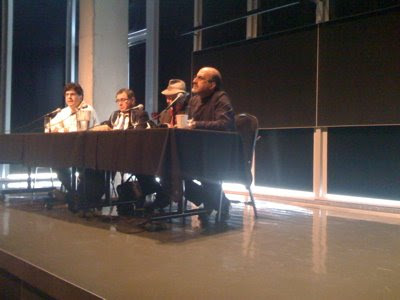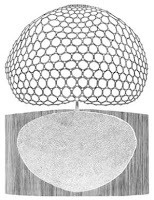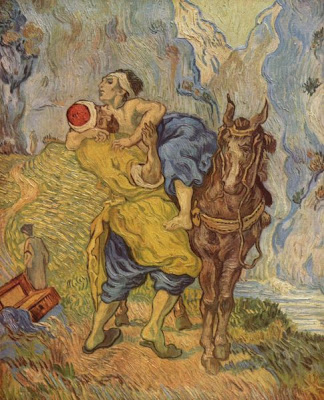Dr.Conway, I thought this might be helpful for you to see the whole works. Not often is perspective in science used to arise above what has been normally happening with the economy to see it in a new light. Imagine using the term "Economic Manhattan Project," for us to consider how seriously this undertaking is presented?
 Photo by Steve Hsu->
Photo by Steve Hsu->
The first photo is the morning panel discussion. From left to right, Eric Weinstein, Nouriel Roubini, Richard Freeman and Nassim Taleb.
The Economic Crisis and its Implications for The Science of Economics.
May 1 - 4, 2009
Perimeter Institute
Concerns over the current financial situation are giving rise to a need to evaluate the very mathematics that underpins economics as a predictive and descriptive science. A growing desire to examine economics through the lens of diverse scientific methodologies - including physics and complex systems - is making way to a meeting of leading economists and theorists of finance together with physicists, mathematicians, biologists and computer scientists in an effort to evaluate current theories of markets and identify key issues that can motivate new directions for research. Perimeter Institute was suggested to be the gathering point and conference organizers plan to foster a very careful, dispassionate discussion, in an atmosphere governed by the modesty and open mindedness that characterizes the scientific community.
The conference will begin on May 1, 2009, with a day of talks by leading experts to an invited audience on the status of economic and financial theory in light of the current situation. Three days of private, focused discussions and workshops will ensue, aimed at addressing complex questions and defining future research agendas for the world that can help address and resolve them.
***Perimeter posted some recommended reading as follows:
***This is a follow up to the conference that has already taken place.
PIRSA:C09006 - The Economic Crisis and It's Implications for The Science of Economics
The Perimeter Institute conference on economics is being organized in an effort to better evaluate the state of economics as a predictive and descriptive science in light of the current market crisis. We believe that this requires careful, dispassionate discussion, in an atmosphere governed by the modesty and open mindedness that characterizes the scientific community. To do this we aim to bring leading economists and theorists of finance together with physicists, mathematicians, biologists and computer scientists to evaluate current theories of markets, and identify key issues that can motivate new directions for research. The conference will begin on May 1, 2009, with a day of invited talks by leading experts to a public audience of around 200 on the status of economic and financial theory in light of the crisis. We will then continue for three days of focused discussion and workshops with an invited group of around 30, aimed at defining research agendas that address that question and beginning work on them. See: Welcome to the Economic Manhattan Project
***Let's keep the issue of economy alive here and the struggle between facets of our society that might develop perspective about a counter culture that exists. This was a inherent struggle diagnosed in Robert Pirsig and John Nash to show, that the ability of any society can become fraught with the struggle to be, always assertively saying who are are by name.
So to continue from the factual explorations science had undertaken, too the story of Angel and Daemons is to realize the struggle society can manifest with itself in an open dialogue with respect to position. It is about being aware first, then knowing that an emotive struggle is to be realized as the ever emotive charge seals memory to its place.
One cannot imagine the full scope with which might respond to criticism about a particular position and point of view. The lesson about Fear is an important one. This distinction needed to be seen in relation to what was being said and could have been mistakenly seen as so.
Yet, it should be noted that while not speaking directly to the fear or that it could it have been thought enduring too, by comment, it was never my intention. That such an action taken by scientist is an example in my books where science is working outside the box to help us see if they can add or change conceptual frameworks that are stuck in the current economic reality.
Learning about Pirsig's use in literary style about rhetoric and oration was a lesson in itself about what and who is speaking. It was about not being stagnant in view of, but taking on the challenge to bring new hope to a current treadmill that mice are running, or "busy bees" are working.
There is a distinction that I had come across in terms of Pessimism and Optimism. It seemingly shows the negative on the one hand, requires one to take stock of, while on the other half of the partnership, is to see that optimism is eventually reached.
One should know that if they take the proper steps in accounting, they can indeed see a brighter future. This in no way should be seen as "fear mongering," but of a responsibility to self and others to check the current situation and to act accordingly.
Of course, you might have seen some of my own pithy attempts at addition? These are listed under the label of Economics. They take to heart that seeing above the dilemma, is to see applicability that would not normally have been entertained.
Emotive StruggleIs not something we can underscore without realizing the impact such emotions may have on a society as a whole. To see that the ideology of the struggle to become better persons, is to unshackle ourselves from those things which hold and bind us to our current, and existing state of mind. That such brief moments of the real you are the respite with which we seek to advance who we are, is to remind ourselves of the person by name we had become.
Are we then not in appearance locked in the battle to become "another person" amongst the struggles of dualism that perpetuate our continuing to run that wheel of life? It would seem then such "a Daemon" that would appear to exist as a counter culture to advancement, would keep us and forever keep us locked in that dualism. You see?
Seeing the images of emotively charge packets are but the process with which to forever remain in that cyclical universe. Is to realize that going "outside the box" is to shock the system and slap it into recognition of moving away from it's "normal attributive" position. If one were to imagine this cloud gathering itself around anyone, then it would have to appear that it always appeared at one spot continually, while the idea is to shift this perspective and shake it from what it has always known.

























